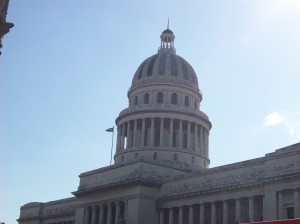Another city I have visited in the past couple years was Havana. This was quite an interesting city to me, because of the contrast between the tourist areas and where the general population lived. It really was beautiful though, as it was first settled by the Spanish, the architecture there was just awesome. The main area I visited was called Centro Havana, which is the main shopping district. There were lots of really cool markets there and it was an experience bartering with the merchants.
The city was very influenced by the baroque era, which is one reason why the city is so cool. The Havana Cathedral is an example of this and was a sweet building to visit and walk around in. There were many modern buildings too, and though I didn’t go in it, one of them is called the Focsa. It has 400 apartments, a supermarket, garages, a restaurant and even a school all contained within. It is massive, and seems like a weird idea, but an intriguing one.
Here is a picture I took of Havana’s Capitol building.
Just thought I would share a bit of this city with you guys. If you ever want to go on a vacation and haven’t been, go to Cuba!


I think the juxtaposition of the “touristy” areas and the “regular” areas is interesting. It reminds me of the Rousification of Baltimore, and the self-conscious attempt to draw tourists in to replace the industrial production of the waterfront. Were the tourist sections in Cuba recycled relics of an older day, as in Baltimore, or were they brand new sites created specifically for this purpose? Did the sites specifically designed for foreigners contain the same regulations as other spaces, or were they subject to their own regulations, as in Peter Hall’s Enterprise Zones? I know in many places in North America prices go up during tourist season, and some cities even charge different rates for locals vs. tourists. Do you think this could be an organic example of Hall’s state-regulated subsidies?
In regards to your question about rates and money, Cuba actually has completely different monetary systems if you are a tourist or a resident. They have convertible pesos for tourists which are almost equivalent to our dollar. But the residents have the regular peso, and 1 convertible peso = 24 regular pesos. But the prices are all the same, which is why for example, the high quality rum there was so cheap for me to buy ($6 for a 2-6), but for a resident it would be 144 pesos for the same item. Average income a month is 180 pesos a month, and even doctors only make about 600 pesos a month.
While I was there, I didn’t realize why there were so many residents doing things such as drawing sketches of tourists while we were touring and then trying to get money from us even though we did not want to be drawn, then I realized that just from our group, one guy had made around $20 from a couple people who liked the drawings. Which when transferred to their currency, is a lot of money. Just a completely different way of living from our own.